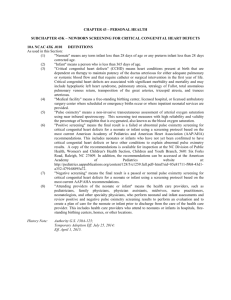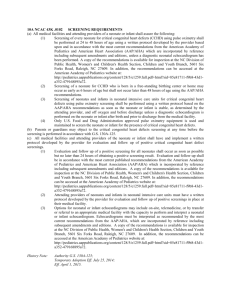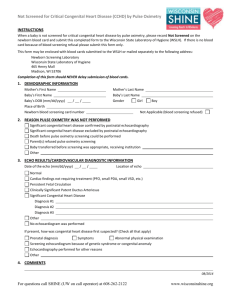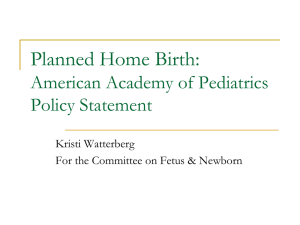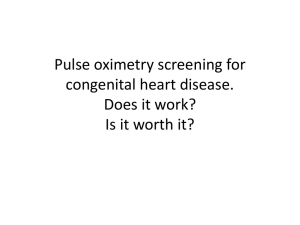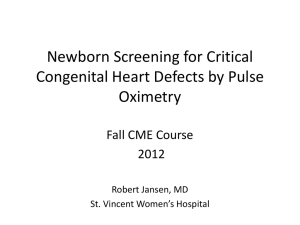CHAPTER 43 – PERSONAL HEALTH subchapter 43K – newborn
advertisement
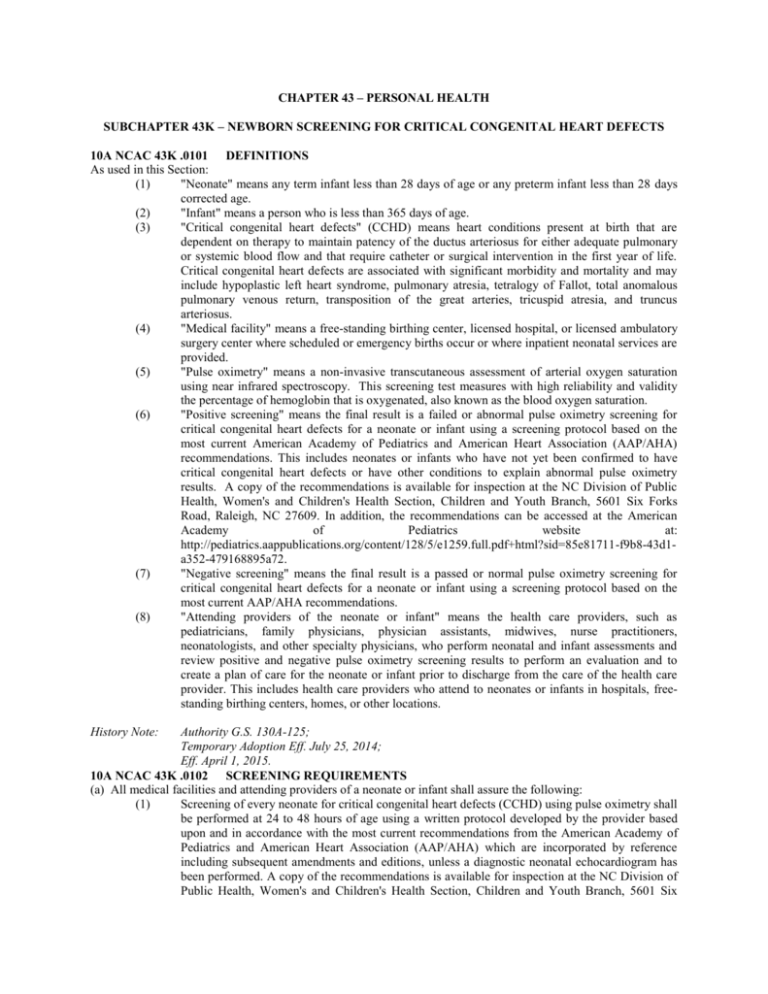
CHAPTER 43 – PERSONAL HEALTH SUBCHAPTER 43K – NEWBORN SCREENING FOR CRITICAL CONGENITAL HEART DEFECTS 10A NCAC 43K .0101 DEFINITIONS As used in this Section: (1) "Neonate" means any term infant less than 28 days of age or any preterm infant less than 28 days corrected age. (2) "Infant" means a person who is less than 365 days of age. (3) "Critical congenital heart defects" (CCHD) means heart conditions present at birth that are dependent on therapy to maintain patency of the ductus arteriosus for either adequate pulmonary or systemic blood flow and that require catheter or surgical intervention in the first year of life. Critical congenital heart defects are associated with significant morbidity and mortality and may include hypoplastic left heart syndrome, pulmonary atresia, tetralogy of Fallot, total anomalous pulmonary venous return, transposition of the great arteries, tricuspid atresia, and truncus arteriosus. (4) "Medical facility" means a free-standing birthing center, licensed hospital, or licensed ambulatory surgery center where scheduled or emergency births occur or where inpatient neonatal services are provided. (5) "Pulse oximetry" means a non-invasive transcutaneous assessment of arterial oxygen saturation using near infrared spectroscopy. This screening test measures with high reliability and validity the percentage of hemoglobin that is oxygenated, also known as the blood oxygen saturation. (6) "Positive screening" means the final result is a failed or abnormal pulse oximetry screening for critical congenital heart defects for a neonate or infant using a screening protocol based on the most current American Academy of Pediatrics and American Heart Association (AAP/AHA) recommendations. This includes neonates or infants who have not yet been confirmed to have critical congenital heart defects or have other conditions to explain abnormal pulse oximetry results. A copy of the recommendations is available for inspection at the NC Division of Public Health, Women's and Children's Health Section, Children and Youth Branch, 5601 Six Forks Road, Raleigh, NC 27609. In addition, the recommendations can be accessed at the American Academy of Pediatrics website at: http://pediatrics.aappublications.org/content/128/5/e1259.full.pdf+html?sid=85e81711-f9b8-43d1a352-479168895a72. (7) "Negative screening" means the final result is a passed or normal pulse oximetry screening for critical congenital heart defects for a neonate or infant using a screening protocol based on the most current AAP/AHA recommendations. (8) "Attending providers of the neonate or infant" means the health care providers, such as pediatricians, family physicians, physician assistants, midwives, nurse practitioners, neonatologists, and other specialty physicians, who perform neonatal and infant assessments and review positive and negative pulse oximetry screening results to perform an evaluation and to create a plan of care for the neonate or infant prior to discharge from the care of the health care provider. This includes health care providers who attend to neonates or infants in hospitals, freestanding birthing centers, homes, or other locations. History Note: Authority G.S. 130A-125; Temporary Adoption Eff. July 25, 2014; Eff. April 1, 2015. 10A NCAC 43K .0102 SCREENING REQUIREMENTS (a) All medical facilities and attending providers of a neonate or infant shall assure the following: (1) Screening of every neonate for critical congenital heart defects (CCHD) using pulse oximetry shall be performed at 24 to 48 hours of age using a written protocol developed by the provider based upon and in accordance with the most current recommendations from the American Academy of Pediatrics and American Heart Association (AAP/AHA) which are incorporated by reference including subsequent amendments and editions, unless a diagnostic neonatal echocardiogram has been performed. A copy of the recommendations is available for inspection at the NC Division of Public Health, Women's and Children's Health Section, Children and Youth Branch, 5601 Six Forks Road, Raleigh, NC 27609. In addition, the recommendations can be accessed at the American Academy of Pediatrics website at: http://pediatrics.aappublications.org/content/128/5/e1259.full.pdf+html?sid=85e81711-f9b8-43d1a352-479168895a72. (2) Screening of a neonate for CCHD who is born in a free-standing birthing center or home may occur as early as 6 hours of age but shall not occur later than 48 hours of age using the AAP/AHA recommendations. (3) Screening of neonates and infants in neonatal intensive care units for critical congenital heart defects using pulse oximetry screening shall be performed using a written protocol based on the AAP/AHA recommendations as soon as the neonate or infant is stable, as determined by the attending provider, and off oxygen and before discharge unless a diagnostic echocardiogram is performed on the neonate or infant after birth and prior to discharge from the medical facility. (4) Only U.S. Food and Drug Administration approved pulse oximetry equipment is used and maintained to screen the neonate or infant for the presence of critical congenital heart defects. (b) Parents or guardians may object to the critical congenital heart defects screening at any time before the screening is performed in accordance with G.S. 130A-125. (c) All medical facilities and attending providers of the neonate or infant shall have and implement a written protocol developed by the provider for evaluation and follow up of positive critical congenital heart defect screenings. (1) Evaluation and follow up of a positive screening for all neonates shall occur as soon as possible but no later than 24 hours of obtaining a positive screening result. Evaluation and follow-up shall be in accordance with the most current published recommendations from the American Academy of Pediatrics and American Heart Association (AAP/AHA) which is incorporated by reference including subsequent amendments and editions. A copy of the recommendations is available for inspection at the NC Division of Public Health, Women's and Children's Health Section, Children and Youth Branch, 5601 Six Forks Road, Raleigh, NC 27609. In addition, the recommendations can be accessed at the American Academy of Pediatrics website at: http://pediatrics.aappublications.org/content/128/5/e1259.full.pdf+html?sid=85e81711-f9b8-43d1a352-479168895a72. (2) Attending providers of neonates and infants in neonatal intensive care units must have a written protocol developed by the provider for evaluation and follow up of positive screenings in place at their medical facility. (3) Options for neonatal or infant echocardiograms may include on-site, telemedicine, or by transfer or referral to an appropriate medical facility with the capacity to perform and interpret a neonatal or infant echocardiogram. Echocardiograms must be interpreted as recommended by the most current recommendations from the AAP/AHA, which are incorporated by reference including subsequent amendments and editions. A copy of the recommendations is available for inspection at the NC Division of Public Health, Women's and Children's Health Section, Children and Youth Branch, 5601 Six Forks Road, Raleigh, NC 27609. In addition, the recommendations can be accessed at the American Academy of Pediatrics website at: http://pediatrics.aappublications.org/content/128/5/e1259.full.pdf+html?sid=85e81711-f9b8-43d1a352-479168895a72. History Note: Authority G.S. 130A-125; Temporary Adoption Eff. July 25, 2014; Eff. April 1, 2015. 10A NCAC 43K .0103 REPORTING REQUIREMENTS (a) All medical facilities and attending providers of neonates or infants performing critical congenital heart defect (CCHD) screening shall report the information described below about positive screenings to a statewide CCHD database maintained by the Perinatal Quality Collaborative of North Carolina (PQCNC). The following information must be reported by medical facilities and attending providers within 7 days of all positive screenings: (1) date and time of birth of the neonate or infant, gestational age, and the medical facility or birth location, and (2) age in hours at time of screening; all pulse oximetry saturation values, including initial, subsequent, and final screening results; final diagnosis if known; any known interventions and treatment, and any need for transport or transfer; and the location of the transfer or transport if known. (b) Within two weeks of receiving a positive screening, PQCNC shall report the above information from the CCHD database to the NC Birth Defects Monitoring Program using a unique identifier generated by the CCHD database for the neonate or infant. The unique identifier shall be retained by the source medical facility or attending provider for help with identification of the neonate or infant. (c) All medical facilities and attending providers of neonates or infants performing critical congenital heart defect screening shall report aggregate information described in Subparagraphs (e)(1) through (e)(7) of this Rule quarterly and no later than 15 days after the end of each quarter of the state fiscal year to a statewide CCHD database maintained by the Perinatal Quality Collaborative of North Carolina (PQCNC). (d) PQCNC shall report the aggregate information described in Sub-paragraphs (e)(1) through (e)(7) to the NC Birth Defects Monitoring Program within 30 days after the end of each quarter of the state fiscal year. (e) The required quarterly aggregate information from medical facilities and attending providers of neonates or infants reported to PQCNC and that PQCNC reports to the NC Birth Defects Monitoring Program shall include the total unduplicated counts of: (1) live births; (2) neonates and infants who were screened; (3) negative screenings; (4) positive screenings; (5) neonates or infants whose parents or guardians objected to the critical congenital heart defect screenings; (6) transfers into the medical facility, not previously screened; and (7) neonates and infants not screened and the reasons if known which include a diagnostic echocardiogram being performed after birth and prior to discharge, transfer out of the medical facility before screening, or death . History Note: Authority G.S. 130A-125; Temporary Adoption Eff. July 25, 2014; Eff. April 1, 2015.
